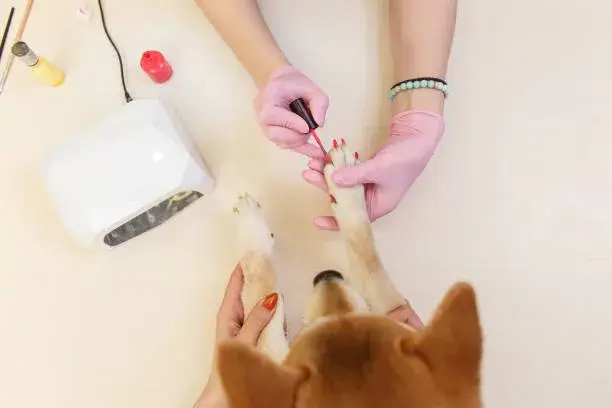Dog nail painting offers a fun and unique way to showcase your pet’s personality. However, ensuring your dog’s safety and comfort throughout the process is crucial. This guide delves into the world of dog nail painting, providing essential tips on product selection, potential concerns, and techniques for a positive experience.
Understanding the Benefits and Drawbacks

Before painting your dog’s nails, it’s important to consider the potential pros and cons:
- Benefits:
- Aesthetics: Adds a touch of personality and style, especially for special occasions.
- Identification: Helps distinguish between dogs with similar appearances.
- Potential Drawbacks:
- Discomfort: Some dogs may dislike having their paws handled.
- Health Risks: Human nail polish contains toxic chemicals harmful to dogs.
- Nail Damage: Frequent painting or improper application can weaken nails.
Carefully consider these factors and always prioritize your dog’s well-being. Stop immediately if your dog shows any distress.
Choosing the Right Products
- Dog-Safe Nail Polish: Opt for non-toxic, water-based polishes specifically designed for dogs. Avoid human nail polish entirely.
- Nail Trimming Tools: Use dog-specific clippers or a grinder if the nails are long. Be sure you understand proper trimming techniques to avoid injuring the quick.
- Nail File: Smooth any rough edges after trimming.
- Cotton Balls and Acetone-Free Remover: For corrections or polish removal.
- Treats and Distractions: Keep your dog happy and relaxed.
Step-by-Step Guide
- Prepare: Choose a calm, well-lit area. Protect surfaces if needed.
- Trim or Grind Nails (if necessary): Use proper technique to avoid pain.
- Clean Nails: Wipe each nail gently with a damp cotton ball.
- Apply Polish: Start with a thin coat, working from the nail tip upwards. Avoid cuticles and paw pads.
- Let Dry Completely: This usually takes a few minutes.
- Additional Coats (optional): Apply more for bolder color, ensuring each coat dries fully.
- Cleanup: Gently remove any mistakes with acetone-free polish remover.
Tips for Creative Nail Art
- Start Simple: Begin with basic patterns like stripes or polka dots.
- Stencils: Help create intricate designs without needing artistic skill.
- Contrasting Colors: Make your designs pop.
- Less is More: Avoid overwhelming your dog’s nails.
Important Considerations

- Breed and Temperament: Some dogs may be more tolerant of nail painting than others. Respect your dog’s comfort level.
- Nail Health: Limit nail painting to special occasions to avoid weakening nails.
- Alternatives: Consider nail stickers or colored caps for a safer, temporary option.
Conclusion
Dog nail painting can be a fun bonding experience when done responsibly. By prioritizing safety, using dog-specific products, and respecting your dog’s preferences, you can add a touch of color and personality to your pet’s life.
I hope you find this article helpful and informative. If Yes’ feel free to share it with your friends!
Frequently Asked Question
Is dog nail painting safe?
Yes, when using dog-safe products and proper techniques.
Can it harm my dog?
Not if done correctly with the right products.
How often can I paint my dog’s nails?
It completely relies on the polish, your dog’s training level, and your dog’s nail growth. Monitor the nail condition and repaint as needed.
